I. What are the Primary and Secondary Lymphoid Organ and Tissues?
When studying the immune system, it’s truly amazing to see the wide variety of organs and tissues that contribute to the development and functioning of the immune system. Probably an even more interesting caveat of this system is that on face value, the organs look so wide spread and really don’t have any connection with one another.
However, rest assured, these organs all operate and communicate with one another in order to ensure a strong, robust immune response can be built during times of infection with the ultimate intent of protecting the body. Let’s go ahead and give a brief overview in regards to the main organs and tissues of the immune system!
II. Primary (1˚) v.s. Secondary (2˚) Lymphoid Organs and Tissues
The various organs and tissues of the immune system can be divided into 2 main categories: primary (1˚) and secondary (2˚) lymphoid organs. The best words to associate with primary lymphoid organs are production and maturation as they are actively involved in the production and maturation of the various immune cells as described in our other articles!
Conversely, the best words to associate with secondary lymphoid organs are supportive and immunostimulatory as these tissue/organs have supportive functions such as cell recycling and also house mature immune cells which can be activated and stimulate an immune response!
A. Primary (1˚) Lymphoid Organs
There are only 2 primary lymphoid organs: the bone marrow and thymus. The bone marrow actually houses the hematopoietic stem cells which are the precursor cells which will eventually give rise to the various cells of the immune system including macrophages, lymphocytes, neutrophils, etc.
It’s important to note the difference in these 2 organs regarding the maturation of B and T cell lymphocytes. After initial development, T cells will continue their development in the thymus gland. Conversely, B cells will continue maturation in the bone marrow.
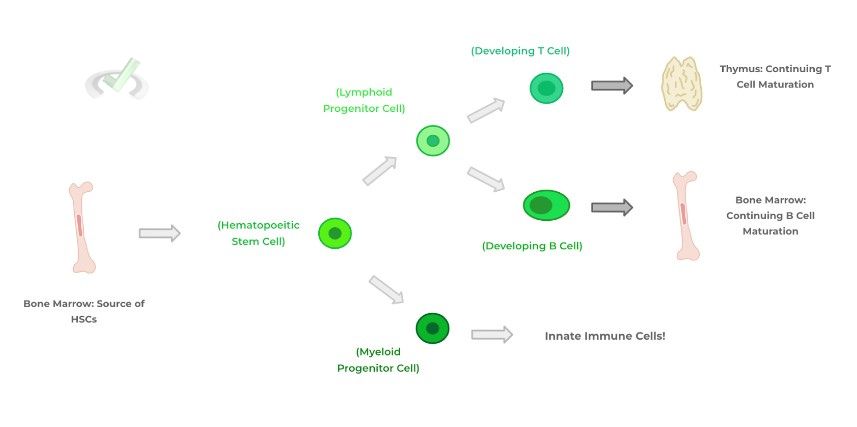
It’s in these primary lymphoid organs where important maturation processes such as somatic recombination, positive and negative selection occurs. We have an in-depth covering of each of these processes in another article!
B. Secondary (2˚) Lymphoid Organs
There are many more 2˚ lymphoid organs which are also more widespread — we’ll go ahead and primarily cover 3 main organs/tissues: lymph nodes, spleen, and MALT which stands for mucosal associated lymphoid tissue! Let’s go ahead and cover them in a bit more detail!
I. Lymph Nodes
Best described as “kidney bean” shaped organs, lymph nodes are scattered throughout the body and are connected to each other via the lymphatic system. Housed within the lymph nodes are various T and B cell lymphocytes which can be activated upon encountering an antigen.
Possible pathogenic antigens coming from systemic tissue can enter into the various lymph nodes through lymphatic vessels. If a possible antigen is present, it will be recognized by the specific B and T cell receptors and initiate an inflammatory response.
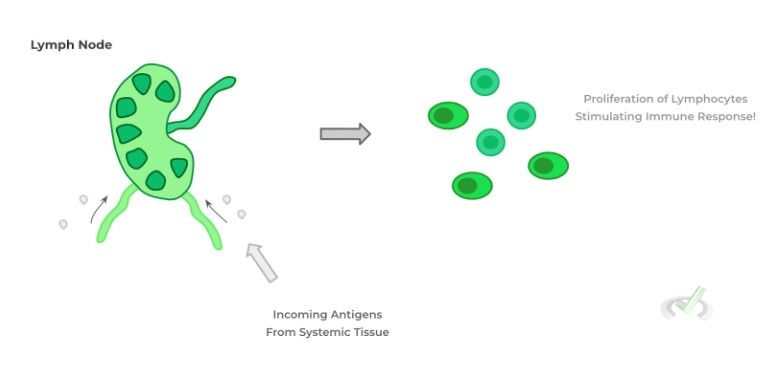
II. Spleen
Located inside of the left rib cage, the spleen is another 2˚ lymphoid organ important in regards to stimulating an immune response in regards to blood borne pathogens. As shown below, this occurs in areas of the spleen called the white pulp which are basically sheaths of lymphocytes which surround arteries with incoming blood.
In addition, the red pulp as shown below is also where the recycling of red blood cells occurs which attests to the double functioning of the spleen as a cardiovascular support organ as well as an immunostimulatory organ!
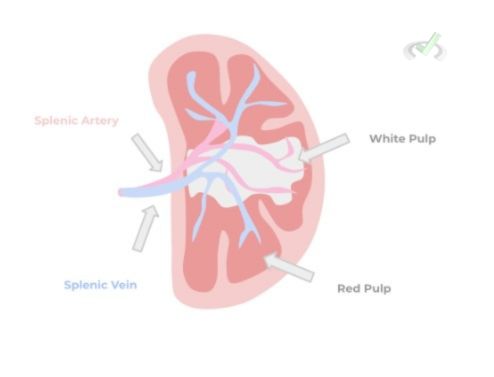
III. MALT (Mucosal Associated Lymphoid Tissue)
Finally, there are various areas in the body which also house similar, abundant collections of immune cell lymphocytes particularly in areas of the body which are associated with mucosal tissue.
As we’d expect, much of the MALT tissue is located in areas of the body which have a high potential to encounter external pathogens. These include Peyer’s patches which are MALT tissue present within the ileum of the small intestine, the tonsils located within the pharynx, the bronchi of the respiratory tract, etc.
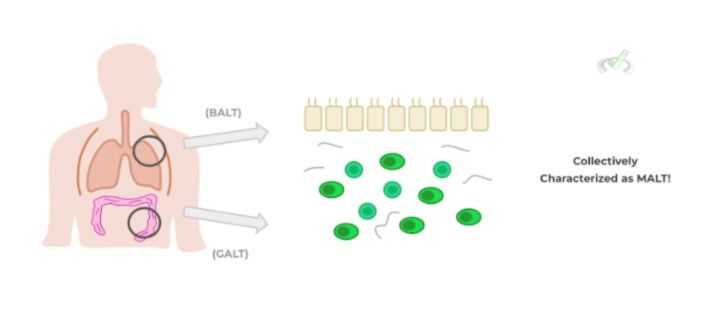
If you want to be more specific, the MALT tissue associated with the gastrointestinal tract is called GALT (gut associated lymphoid tissue) while MALT tissue associated with the bronchial lining is called BALT (bronchus associated lymphoid tissue).
III. Bridge/Overlap
Now knowing the main role of the primary (1˚) lymphoid organs are to facilitate the proper production and maturation of immune cells, we can perhaps introduce (or review if you’ve covered our “Immunological Processes: Clonal Selection and Maturation” article) some key maturation features and associate them with where they take place in the primary lymphoid organs!
I. Maturation Processes and Location Reference within Primary Lymphoid Organs
Recall that somatic recombination refers to the rearrangement and combination of gene segments within precursor B and T cells in order to generate a B/T cell receptor that’s specific for one pathogenic antigen! Because this process occurs in precursor B and T cells, somatic recombination occurs within the bone marrow!
Conversely, the positive and negative selection which occurs for developing T cells occurs in the thymus! Recall that these processes ensure that the T cell receptor generated can bind with high affinity to self-MHC molecules and ARE NOT reactive to self/host antigens.
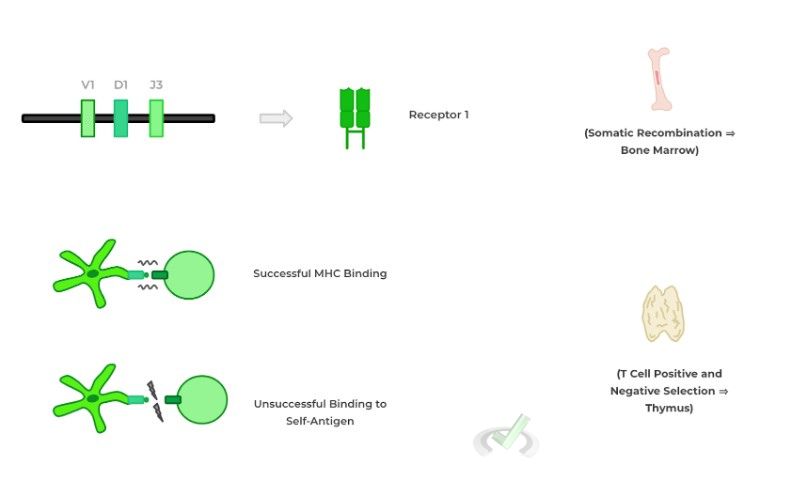
IV. Wrap Up/Key Terms
Let’s take this time to wrap up & concisely summarize what we covered above in the article!
A. Primary (1˚) Lymphoid Organs
The best words to attribute to the primary lymphoid organs, which include the bone marrow and thymus, are the production and maturation of immune cells due to the presence of hematopoietic stem cells.
In regards to lymphocyte maturation, both T and B cell precursors are produced in the bone marrow. However, T cells go on to mature in the thymus while B cells remain in the bone marrow to mature.
B. Secondary (2˚) Lymphoid Organs
The best phrase to attribute to the secondary lymphoid organs are supportive and immunostimulatory/activating. The main secondary lymphoid organs of importance are lymph nodes, the spleen, and MALT (mucosal associated lymphoid tissue)
I. Lymph Nodes
These are kidney bean shaped organs scattered throughout the body connected via lymphatic vessels. These house abundant lymphocytes which can be activated upon encountering antigens arriving via lymphatic vessels.
II. Spleen
Located within the left ribcage, the spleen allows for both the recycling of red blood cells which occurs within the red pulp of the spleen and the stimulation of lymphocytes against blood borne pathogens via the white pulp.
III. MALT
Finally, MALT (mucosal associated lymphoid tissue) refers to areas of the body with mucosal lining that also possess an underlying high concentration of immune cells and lymphocytes similar to lymph nodes,
This mucosal lining with associated lymphoid tissue is located in areas of the body which have a high probability of being exposed to external pathogens such as the GI tract and the respiratory tract.
V. Practice
Take a look at these practice questions to see and solidify your understanding!
Sample Practice Question 1
Complete the statement below.
Maturation of T cells occurs at a ___________ lymphoid organ, specifically the ____________.
A. Primary, Bone Marrow
B. Primary, Thymus
C. Secondary, Bone Marrow
D. Secondary, Thymus
Ans.B
The main functions of the primary lymphoid organs are to allow for the production and maturation of immune cells. Both the precursors for B and T cells are produced in the bone marrow; however, B cells continue to mature in the bone marrow while T cells go on to mature in the thymus.
Sample Practice Question 2
The Hepatitis B virus is particularly dangerous due to its nature of being a blood borne pathogen which has the possibility to cause systemic infection. As such, which of the following organs would you expect to be most effective in clearing this infection upon encounter?
A. Spleen
B. Cervical Lymph Nodes
C. Peyer’s Patches
D. BALT
Ans. A
Being that the Hep B virus is a blood borne pathogen, it will probably be recognized by the lymphocytes located within the spleen, specifically at the white pulp. After stimulation of the lymphocytes with the appropriate receptor they then proliferate to allow for a proper immune response to take place.







 To help you achieve your goal MCAT score, we take turns hosting these
To help you achieve your goal MCAT score, we take turns hosting these 





















 reviews on TrustPilot
reviews on TrustPilot